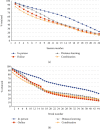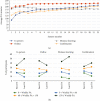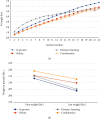Delivering the National Diabetes Prevention Program: Assessment of Outcomes in In-Person and Virtual Organizations
- PMID: 37928892
- PMCID: PMC10622599
- DOI: 10.1155/2023/8894593
Delivering the National Diabetes Prevention Program: Assessment of Outcomes in In-Person and Virtual Organizations
Abstract
The Centers for Disease Control and Prevention's Diabetes Prevention Recognition Program (DPRP) has helped organizations deliver the National Diabetes Prevention Program (National DPP) lifestyle change program for over 10 years. Four delivery modes are now approved: in person, online (self-paced, asynchronous delivery), distance learning (remote, synchronous delivery), and combination (hybrid delivery using more than one delivery mode). We assessed outcomes using data from 333,715 participants who started the 12-month program between January 1, 2012, and December 31, 2018. The average number of sessions attended was highest for in-person participants (15.0), followed by online (12.9), distance learning (12.2), and combination (10.7). The average number of weeks in the program was highest for in-person participants (28.1), followed by distance learning (20.1), online (18.7), and combination (18.6). The average difference between the first and last reported weekly physical activity minutes reflected an increase for in person (42.0), distance learning (27.1), and combination (15.0), but a decrease for online (-19.8). Among participants retained through session 6 or longer, average weekly physical activity minutes exceeded the program goal of 150 for all delivery modes. Average weight loss (percent of body weight) was greater for in person (4.4%) and distance learning (4.7%) than for online (2.6%) or combination (2.9%). Average participant weight loss increased gradually by session for all delivery modes; among participants who remained in the program for 22 sessions, average weight loss exceeded the program goal of 5% for all delivery modes. In summary, if participants stay in the program, most have positive program outcomes regardless of delivery mode; they have some outcome improvement even if they leave early; and their outcomes improve more the longer they stay. This highlights the benefits of better retention and increased enrollment in the National DPP lifestyle change programs, as well as enhancements to online delivery.
Copyright © 2023 Elizabeth K. Ely et al.
Conflict of interest statement
The authors have no potential conflicts of interest relevant to this article.
Figures






Similar articles
-
Delivering the National Diabetes Prevention Program: Assessment of Retention, Physical Activity, and Weight Loss Outcomes by Participant Characteristics and Delivery Modes.J Diabetes Res. 2024 Aug 13;2024:8461704. doi: 10.1155/2024/8461704. eCollection 2024. J Diabetes Res. 2024. PMID: 39165352 Free PMC article.
-
Delivering the National Diabetes Prevention Program: Assessment of Enrollment in In-Person and Virtual Organizations.J Diabetes Res. 2022 Feb 1;2022:2942918. doi: 10.1155/2022/2942918. eCollection 2022. J Diabetes Res. 2022. PMID: 35118160 Free PMC article.
-
A National Effort to Prevent Type 2 Diabetes: Participant-Level Evaluation of CDC's National Diabetes Prevention Program.Diabetes Care. 2017 Oct;40(10):1331-1341. doi: 10.2337/dc16-2099. Epub 2017 May 12. Diabetes Care. 2017. PMID: 28500215 Free PMC article.
-
Retention Among Participants in the National Diabetes Prevention Program Lifestyle Change Program, 2012-2017.Diabetes Care. 2020 Sep;43(9):2042-2049. doi: 10.2337/dc19-2366. Epub 2020 Jul 2. Diabetes Care. 2020. PMID: 32616617 Free PMC article.
-
[Steps toward the primary prevention of type II diabetes mellitus. Various epidemiological considerations].Invest Clin. 1997 Mar;38(1):39-52. Invest Clin. 1997. PMID: 9235072 Review. Spanish.
Cited by
-
Is the Current Lifestyle Modification Approach to Diabetes Prevention in the U.S. a Success?Diabetes Care. 2025 Jun 1;48(6):863-870. doi: 10.2337/dci24-0040. Diabetes Care. 2025. PMID: 40267363 Review.
-
Neighborhood socioeconomic disadvantage and travel time to diabetes prevention programs in Maryland.Health Place. 2025 Jul;94:103470. doi: 10.1016/j.healthplace.2025.103470. Epub 2025 Apr 30. Health Place. 2025. PMID: 40311378
-
Preferences for receiving diabetes prevention support and factors influencing healthy eating and physical activity and among patients with prediabetes in Chicago, Illinois.Prev Med Rep. 2025 Apr 28;54:103090. doi: 10.1016/j.pmedr.2025.103090. eCollection 2025 Jun. Prev Med Rep. 2025. PMID: 40395685 Free PMC article.
-
Assessing the Fit of a Digitally Delivered National Diabetes Prevention Program Among Rural Living Adults: Qualitative Study.JMIR Form Res. 2025 Jul 2;9:e70406. doi: 10.2196/70406. JMIR Form Res. 2025. PMID: 40601375 Free PMC article.
-
Advancing Type 2 Diabetes Prevention through Text-Messaging Interventions: A Narrative Review.Curr Diab Rep. 2024 Dec 4;25(1):9. doi: 10.1007/s11892-024-01568-w. Curr Diab Rep. 2024. PMID: 39630283 Free PMC article.
References
-
- Centers for Disease Control and Prevention. Centers for Disease Control and Prevention Diabetes Prevention Recognition Program. 2021. https://www.cdc.gov/diabetes/prevention/pdf/dprp-standards.pdf.
MeSH terms
LinkOut - more resources
Full Text Sources
Medical

